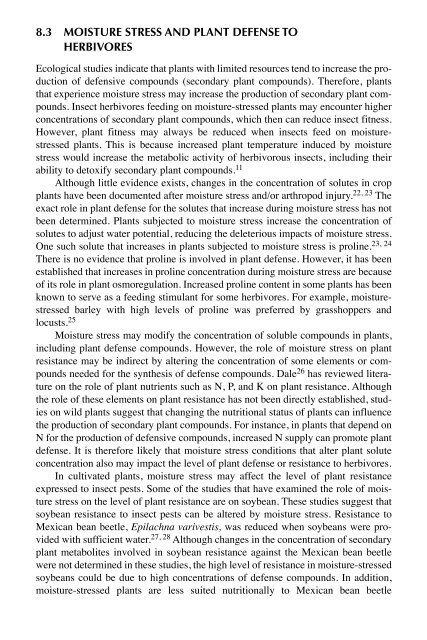Biotic Stress and Yield Loss
Biotic Stress and Yield Loss
Biotic Stress and Yield Loss
- No tags were found...
You also want an ePaper? Increase the reach of your titles
YUMPU automatically turns print PDFs into web optimized ePapers that Google loves.
8.3 MOISTURE STRESS AND PLANT DEFENSE TOHERBIVORESEcological studies indicate that plants with limited resources tend to increase the productionof defensive compounds (secondary plant compounds). Therefore, plantsthat experience moisture stress may increase the production of secondary plant compounds.Insect herbivores feeding on moisture-stressed plants may encounter higherconcentrations of secondary plant compounds, which then can reduce insect fitness.However, plant fitness may always be reduced when insects feed on moisturestressedplants. This is because increased plant temperature induced by moisturestress would increase the metabolic activity of herbivorous insects, including theirability to detoxify secondary plant compounds. 11Although little evidence exists, changes in the concentration of solutes in cropplants have been documented after moisture stress <strong>and</strong>/or arthropod injury. 22, 23 Theexact role in plant defense for the solutes that increase during moisture stress has notbeen determined. Plants subjected to moisture stress increase the concentration ofsolutes to adjust water potential, reducing the deleterious impacts of moisture stress.One such solute that increases in plants subjected to moisture stress is proline.23, 24There is no evidence that proline is involved in plant defense. However, it has beenestablished that increases in proline concentration during moisture stress are becauseof its role in plant osmoregulation. Increased proline content in some plants has beenknown to serve as a feeding stimulant for some herbivores. For example, moisturestressedbarley with high levels of proline was preferred by grasshoppers <strong>and</strong>locusts. 25Moisture stress may modify the concentration of soluble compounds in plants,including plant defense compounds. However, the role of moisture stress on plantresistance may be indirect by altering the concentration of some elements or compoundsneeded for the synthesis of defense compounds. Dale 26 has reviewed literatureon the role of plant nutrients such as N, P, <strong>and</strong> K on plant resistance. Althoughthe role of these elements on plant resistance has not been directly established, studieson wild plants suggest that changing the nutritional status of plants can influencethe production of secondary plant compounds. For instance, in plants that depend onN for the production of defensive compounds, increased N supply can promote plantdefense. It is therefore likely that moisture stress conditions that alter plant soluteconcentration also may impact the level of plant defense or resistance to herbivores.In cultivated plants, moisture stress may affect the level of plant resistanceexpressed to insect pests. Some of the studies that have examined the role of moisturestress on the level of plant resistance are on soybean. These studies suggest thatsoybean resistance to insect pests can be altered by moisture stress. Resistance toMexican bean beetle, Epilachna varivestis, was reduced when soybeans were providedwith sufficient water. 27, 28 Although changes in the concentration of secondaryplant metabolites involved in soybean resistance against the Mexican bean beetlewere not determined in these studies, the high level of resistance in moisture-stressedsoybeans could be due to high concentrations of defense compounds. In addition,moisture-stressed plants are less suited nutritionally to Mexican bean beetle

















